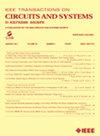基于上升时间控制技术的SRAM容偏体偏感放大器
IF 4.9
2区 工程技术
Q2 ENGINEERING, ELECTRICAL & ELECTRONIC
IEEE Transactions on Circuits and Systems II: Express Briefs
Pub Date : 2025-04-07
DOI:10.1109/TCSII.2025.3558562
引用次数: 0
摘要
在本文中,我们提出了一种具有上升时间$(T_{\mathrm { RISE}})$控制技术的容偏体偏感测放大器(OTB-SA),以解决当锁存型SA的输入电压差$({\Delta }V_{\mathrm { BL}})$小于失调电压$(V_{\mathrm { OS}})$时发生的感测故障问题。具有$T_{\mathrm { RISE}}$的OTB-SA利用体偏置和$T_{\mathrm { RISE}}$控制来增强差分信号注入(DSI)效果,从而降低$V_{\mathrm { OS}}$和能量消耗。采用28 nm工艺模型的布局后HSPICE仿真结果表明,当目标$V_{\mathrm { OS}}$标准差$({\sigma }_{\mathrm { OS}})$为5 mV时,$T_{\mathrm { RISE}}$的OTB-SA达到49.6% reduction in area and a 60.1% decrease in energy consumption compared to a voltage-latched SA (VLSA) without $T_{\mathrm { RISE}}$ . Moreover, compared to previous SAs, the OTB-SA with $T_{\mathrm { RISE}}$ showed up to 69.1% area reduction and up to 91.2% energy consumption reduction. Measurements from a 28 nm test chip confirmed that $T_{\mathrm { RISE}}$ control is effective, showing a trend where ${\sigma }_{\mathrm { OS}}$ decreases as $T_{\mathrm { RISE}}$ increases for OTB-SA.本文章由计算机程序翻译,如有差异,请以英文原文为准。
Offset-Tolerant Body-Biased Sense Amplifier With Rise-Time Control Technique for SRAM
In this brief, we propose an Offset-Tolerant Body-biased sense amplifier (OTB-SA) with a rise-time $(T_{\mathrm { RISE}})$ control technique to address the sensing failure issue that occurs when the input voltage difference $({\Delta }V_{\mathrm { BL}})$ of a latch-type SA is smaller than the offset voltage $(V_{\mathrm { OS}})$ . The OTB-SA with $T_{\mathrm { RISE}}$ leverages body biasing and $T_{\mathrm { RISE}}$ control to enhance the differential signal injection (DSI) effect, thereby reducing both $V_{\mathrm { OS}}$ and energy consumption. Post-layout HSPICE simulation results using a 28 nm technology model indicate that, when target $V_{\mathrm { OS}}$ standard deviation $({\sigma }_{\mathrm { OS}})$ is 5 mV, the OTB-SA with $T_{\mathrm { RISE}}$ achieves a 49.6% reduction in area and a 60.1% decrease in energy consumption compared to a voltage-latched SA (VLSA) without $T_{\mathrm { RISE}}$ . Moreover, compared to previous SAs, the OTB-SA with $T_{\mathrm { RISE}}$ showed up to 69.1% area reduction and up to 91.2% energy consumption reduction. Measurements from a 28 nm test chip confirmed that $T_{\mathrm { RISE}}$ control is effective, showing a trend where ${\sigma }_{\mathrm { OS}}$ decreases as $T_{\mathrm { RISE}}$ increases for OTB-SA.
求助全文
通过发布文献求助,成功后即可免费获取论文全文。
去求助
来源期刊
CiteScore
7.90
自引率
20.50%
发文量
883
审稿时长
3.0 months
期刊介绍:
TCAS II publishes brief papers in the field specified by the theory, analysis, design, and practical implementations of circuits, and the application of circuit techniques to systems and to signal processing. Included is the whole spectrum from basic scientific theory to industrial applications. The field of interest covered includes:
Circuits: Analog, Digital and Mixed Signal Circuits and Systems
Nonlinear Circuits and Systems, Integrated Sensors, MEMS and Systems on Chip, Nanoscale Circuits and Systems, Optoelectronic
Circuits and Systems, Power Electronics and Systems
Software for Analog-and-Logic Circuits and Systems
Control aspects of Circuits and Systems.

 求助内容:
求助内容: 应助结果提醒方式:
应助结果提醒方式:


